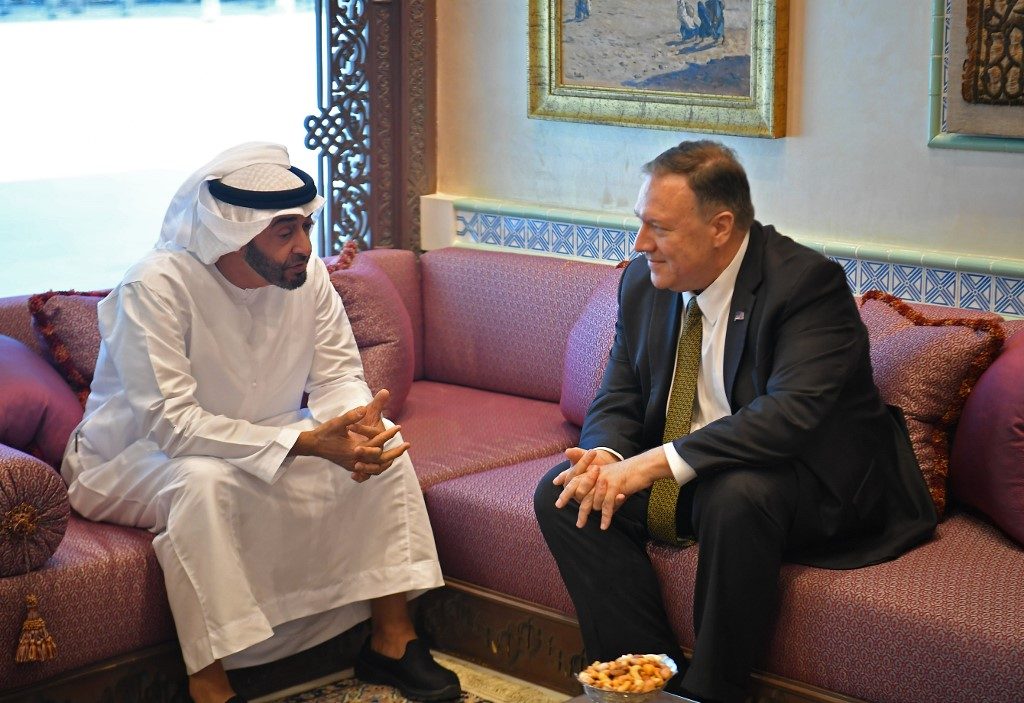SUMMARY
This is AI generated summarization, which may have errors. For context, always refer to the full article.

DUBAI, United Arab Emirates – The US wants a peaceful solution to the crisis sparked by attacks on Saudi oil installations, Secretary of State Mike Pompeo said Thursday, September 19, after Iran raised the specter of “all-out war”.
Pompeo has blamed Iran for the dramatic weekend assault on two facilities, condemning an “act of war” which knocked out half the kingdom’s oil production.
The rhetoric has raised the risk of an unpredictable escalation in a tinderbox region where Saudi Arabia and Iran are locked in a decades-old struggle for dominance.
After meeting with allies in Riyadh and Abu Dhabi, Pompeo said there was an “enormous consensus in the region” that Iran carried out the attacks, despite its denials and Yemeni rebels’ claims that they were responsible.
But Pompeo said the US was intent on finding a way out of the confrontation.
“We’d like a peaceful resolution. I think we’ve demonstrated that,” he told reporters.
“I hope the Islamic Republic of Iran sees it the same way.”
Iran’s Foreign Minister Mohammad Javad Zarif earlier warned any US or Saudi military strike on Iran could lead to “all-out war”.
“We don’t want war,” he told CNN in an interview aired Thursday, “but we won’t blink to defend our territory.”
Saudi foreign affairs minister Adel al-Jubeir warned on Twitter that complacency towards Iran will encourage it to “commit more acts of terrorism and sabotage in our region”.
‘Glass towers’
Saudi officials on Wednesday, September 18, unveiled what they said were fragments of 25 drones and cruise missiles fired Saturday, September 14, at the oil facilities in the country’s east, engulfing them in flames.
“The attack was launched from the north and unquestionably sponsored by Iran,” defense ministry spokesman Turki al-Maliki said, although he refused to be drawn on whether Saudi officials believed Iran directly carried out the operation.
Tehran-linked Huthi rebels in Saudi Arabia’s southern neighbor Yemen have claimed responsibility, but both Washington and Riyadh have said the operation was beyond the Yemeni insurgents’ capabilities.
French Foreign Minister Jean-Yves Le Drian also said the Huthi claim “lacks credibility”.
The Huthis have however previously hit dozens of targets in Saudi Arabia, and their rapidly advancing arsenal has exposed the kingdom’s vulnerability despite its vast military spending.
The rebel group said Saturday’s assault was launched from 3 locations inside Yemen, using advanced drones with long-range capabilities.
They also threatened the United Arab Emirates – a key member of the Saudi-led coalition fighting the Shiite rebels – with strikes against “towers made of glass that cannot withstand one drone”, in apparent reference to the glitzy cities of Dubai and Abu Dhabi.
In its first known strike since the oil attacks, the coalition said Thursday night it had launched a military operation against the Yemeni rebels, destroying 4 sites north of the port city of Hodeida.
It came after the coalition said it intercepted a “remote-controlled, booby-trapped boat” that the rebels aimed to use for a “terrorist act in the south of Red Sea”, according to a statement released by the official Saudi Press Agency.
‘New context’
US military planners weighing retaliation have reportedly prepared a list of Iranian targets including the Abadan oil refinery, one of the world’s largest, and Khark Island, the country’s biggest crude export facility, the New York Times said.
Other potential targets include missile launch sites and other assets of the elite Islamic Revolutionary Guard Corps, along with bases near the Gulf.
The United Nations said Thursday that experts had arrived in Saudi Arabia to investigate Saturday’s attack, “at the invitation of the Saudi authorities”.
US officials quoted by CBS News say unreleased satellite photos showed Iran’s Revolutionary Guard Corps making preparations for the attack at Ahvaz airbase.
The latest spike in tensions has dampened speculation of a meeting between US President Donald Trump and his Iranian counterpart Hassan Rouhani on the sidelines of the United Nations General Assembly next week.
French President Emmanuel Macron has been pushing for the meeting to defuse the standoff over the Iranian nuclear program.
But on Thursday, a French presidential official who asked not to be named said Saturday’s attack “creates a new context”.
“There are still lots of things to sort out before we can see how to create the conditions for the United States and Iran to enter into a negotiation,” the official said.
Iran’s foreign ministry reported Thursday that Zarif was set to leave for New York on Friday, September 20, implying that both he and Rouhani had received visas for the UN summit.
However, with tensions in the Gulf once again threatening to bubble over, Cinzia Bianco, a Middle East analyst at the European Council on Foreign Relations, warned of “an out-of-control chain of escalatory events.”
“Inside Saudi Arabia, there is uncertainty over the most appropriate course of action,” she told AFP.
“However the dominant thinking there points to the US targeting critical infrastructure in Iran so as to minimize or exclude any human cost.” – Rappler.com
Add a comment
How does this make you feel?
There are no comments yet. Add your comment to start the conversation.